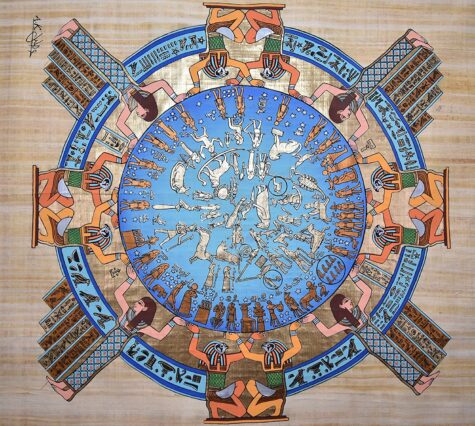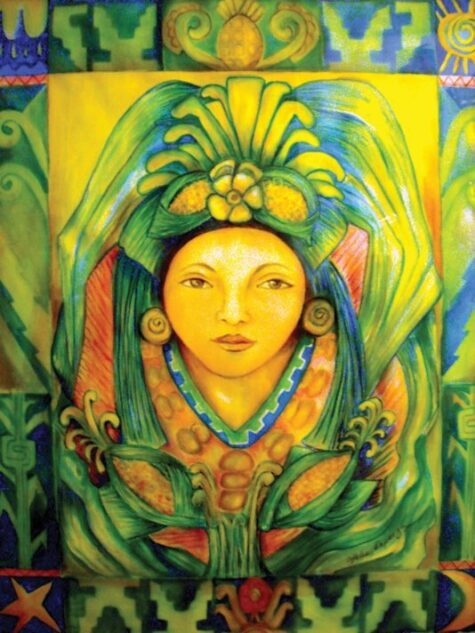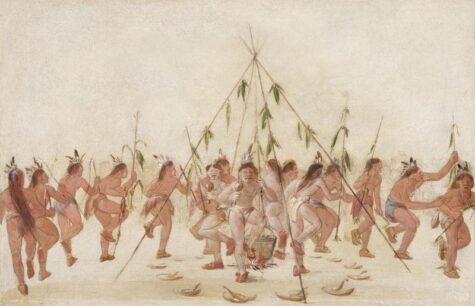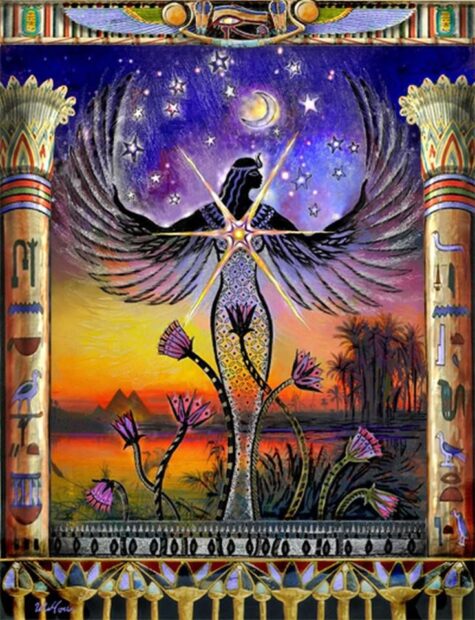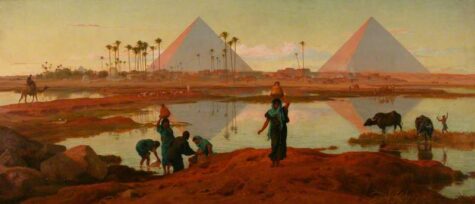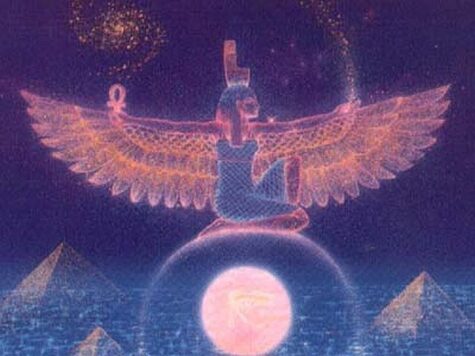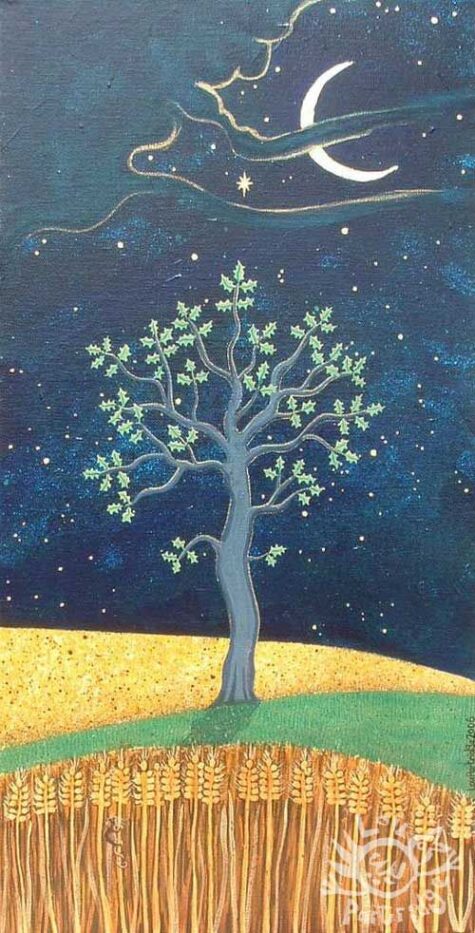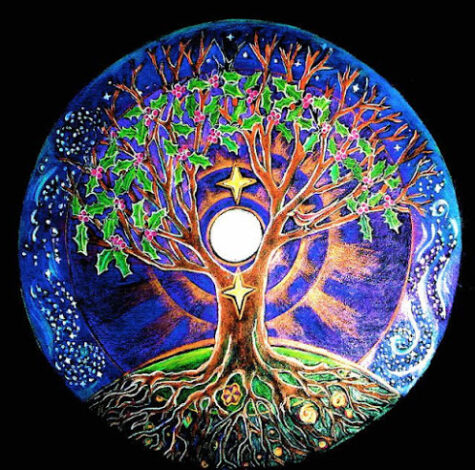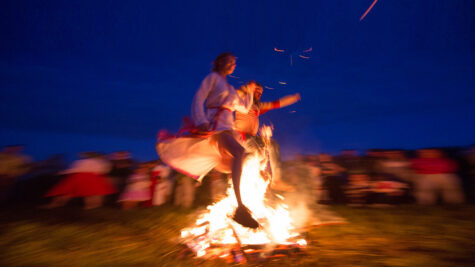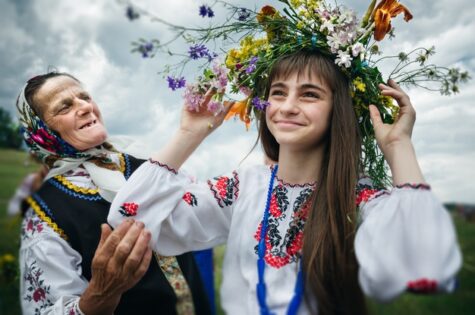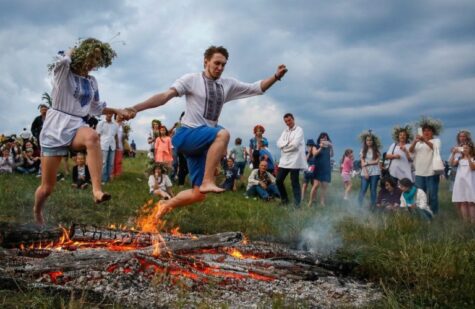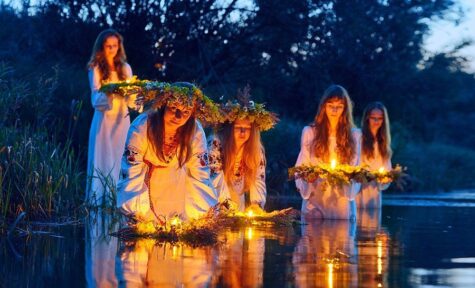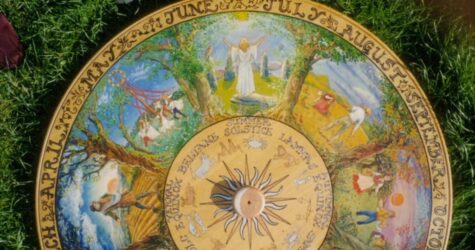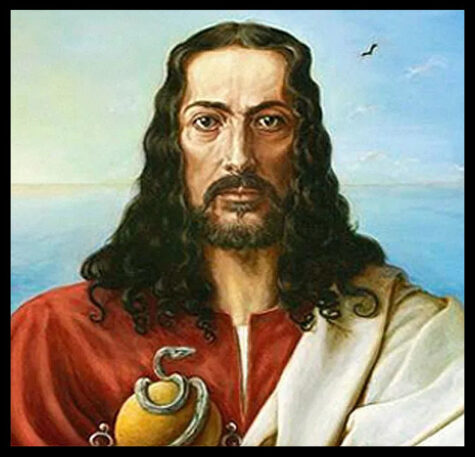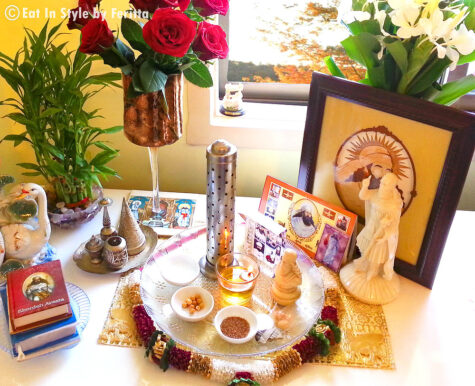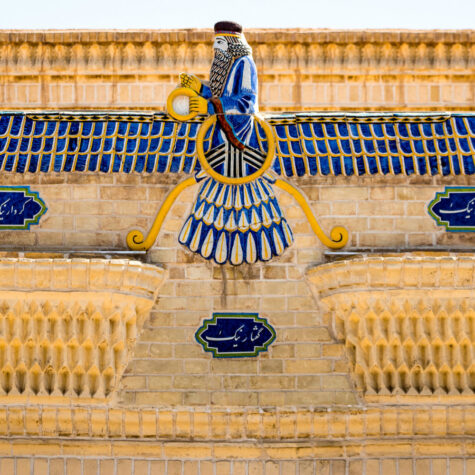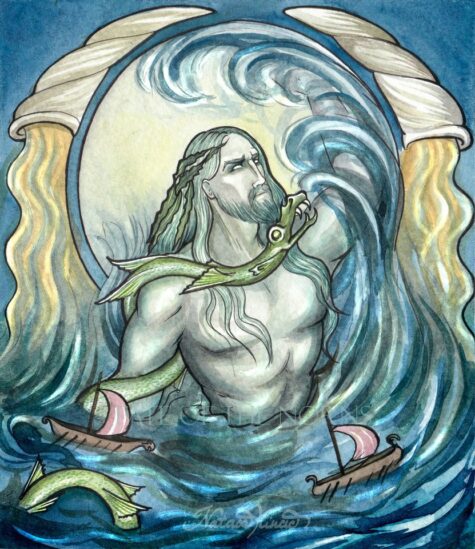July
The 5 Epagomenal Days (6 during leap years) were inserted into the Egyptian Calendar which had been 360 days long. These days were reserved as birthdays for the gods. The first, third, and fifth of these days were considered unlucky by the Egyptians.
The legend behind the days holds the Nut had been forbidden to have children on any day of the year by her husband Geb. Thoth, upon hearing this, gambled with the moon-god for a fraction of his light. Thoth won and he created the additional 5 days for Nut so she could bear children on these days “not of the year.”
They are as follows:
- July 27 – 1st Epagomenal Day – Birthday of Osiris
- July 28 – 2nd Epagomenal Day – Birthday of Horus
- July 29 – 3rd Epagomenal Day – Birthday of Set
- July 30 – 4th Epagomenal Day – Birthday of Isis
- July 31 – 5th Epagomenal Day – Birthday of Nephthys
Note:
These dates come from Traci de Regulla in The Mysteries of Isis. She took her dating from Dr. Robert Brier’s Ancient Egyptian Magic. There is a great deal of dispute when it comes to calculating the dates of Egyptian festivals due to problems in their calendar system (it was only 360 days for some period of time).
The Green Corn Ceremony typically occurs in late July– early August, determined locally by the ripening of the corn crops. The ceremony is marked with dancing, feasting, fasting and religious observations.
The Green Corn Ceremony is a celebration of many types, representing new beginnings. Also referred to as the Great Peace Ceremony, it is a celebration of thanksgiving to Hsaketumese (The Breath Maker) for the first fruits of the harvest, and a New Year festival as well.
The Feast of Green Corn and Dance gives honor to Mantoo (Creator) provider of all things and celebrates our harvest, ancestors, elders, veterans, family and Native American heritage.
The Green Corn Ceremony is an annual ceremony practiced among various Native American peoples associated with the beginning of the yearly corn harvest.
These ceremonies have been documented ethnographically throughout the North American Eastern Woodlands and Southeastern tribes. Historically, it involved a first fruits rite in which the community would sacrifice the first of the green corn to ensure the rest of the crop would be successful.
These Green Corn festivals were practiced widely throughout southern North America by many tribes evidenced in the Mississippian people and throughout the Mississippian Ideological Interaction Sphere. Green Corn festivals are still held today by many different Southeastern Woodland tribes.
Literally the spirit of the corn in Native American traditions, Corn Mother brings with her the bounty of earth, its healing capabilities, it’s nurturing nature, and its providence.
- Symbols: Corn; Corn Sheaves
- Themes: Abundance; Children; Energy; Fertility; Harvest; Health; Grounding; Providence; Strength
This is the season when Corn Mother really shines, beautiful with the harvest. She is happy to share of this bounty and give all those who seek her an appreciation of self, a healthy dose of practicality, and a measure of good common sense.
To Do Today:
Around this time of year the Seminole Indians (in the Florida area) dance the green corn dance to welcome the crop and ensure ongoing fertility in the fields and tribe. This also marks the beginning of the Seminole year. So, if you enjoy dancing, grab a partner and dance? Or, perhaps do some dance aerobics. As you do, breathe deeply and release your stress into Corn Mother’s keeping. she will turn it into something positive, just as the land takes waste and makes it into beauty.
Using corn in rituals and spells is perfectly fitting for this occasion. Scatter cornmeal around the sacred space to mark your magic circle, or scatter it to the wind so Corn Mother can bring fertility back to you. Keeping a dried ear of corn in the house invokes Corn Mother’s protection and luck, consuming corn internalizes her blessings.
The traditional Ceremony:
The Busk or Green Corn Ceremony is the celebration of the New Year, so at this time all offenses are forgiven except for rape and murder, which are executable or banishable offenses.
In modern tribal towns and Stomp Dance societies only the ceremonial fire, the cook fires and certain other ceremonial objects will be replaced. Everyone usually begins gathering by the weekend prior to the ceremony, working, praying, dancing and fasting off and on until the big day.
The whole festival tends to last seven-eight days, if you include the historical preparation involved (without the preparation, it lasts about four days).
- Day One
The first day of the ceremony, people set up their campsites on one of the square ceremonial grounds. Following this, there is a feast of the remains of last year’s crop, after which all the men of the community begin fasting (historically, the women were considered too weak to participate). That night there is a social stomp dance, unique to the Muscogee and Southeastern cultures.
- Day Two
Before dawn on the second day, four brush-covered arbors are set up on the edges of the ceremonial grounds, one in each of the sacred directions.
For the first dance of the day, the women of the community participate in a Ribbon or Ladies Dance, which involves fastening rattles and shells to their legs perform a purifying dance with special ribbon-clad sticks to prepare the ceremonial ground for the renewal ceremony.
The ceremonial fire is set in the middle of four logs laid crosswise, so as to point to the four directions. The Mico (head priest) takes out a little of each of the new crops (not just corn, but beans, squash, wild plants, and others) rubbed with bear oil, and it is offered together with some meat as “first-fruits” and an atonement for all sins.
The fire (which has been re-lit and nurtured with a special medicine by the Mico) will be kept alive until the following year’s Green Corn Ceremony. In traditional times, the women would sweep out their cook-fires and the rest of their homes and collect the filth from this, as well as any old clothing and furniture to be burnt and replaced with new items for the new year.
The women then bring the coals of the fire into their homes, to rekindle their home fires. They can then bake the new fruits of the year over this fire (also to be eaten with bear oil). Many Creeks also practice the sapi or ceremonial scratches, a type of bloodletting in the mid morning, and in many tribes the men and women might rub corn milk, ash, white clay, or analogous mixtures over themselves and bathe as a form of purification.
They also drink a medicine referred to as the “White Drink.” (English traders referred to it as the “Black Drink” due to its dark liquid which froths white when shaken before drinking).
This White Drink, known to strangers as Carolina Tea, is a caffeine-laden mixture of seven to fourteen different herbs, the main ingredient being assi-luputski, Creek for “small leaves” of Yaupon Holly.
This medicine was intended to help receive purification, as it is a purgative when consumed in mass amounts. (Historically, only men drank enough of the liquid to throw up.) The purgative was consumed to clean the dietary tract of last year’s crop and to truly renew oneself for the new year.
- Day Three
While the second day tends to focus on the women’s dance, the third is focused on the men’s. After the purification of the second day, men of the community perform the Feather Dance to heal the community.
The fasting usually ends by supper-time after the word is given by the women that the food is prepared, at which time the men march in single-file formation down to a body of water, typically a flowing creek or river for a ceremonial dip in the water and private men’s meeting. They then return to the ceremonial square and perform a single Stomp Dance before retiring to their home camps for a feast.
During this time, the participants in the medicine rites are not allowed to sleep, as part of their fast. At midnight a Stomp Dance ceremony is held, which includes feasting and continues on through the night. This ceremony usually ends shortly after dawn.
- Day Four
The fourth day has friendship dances at dawn, games, and people later pack up and return home with their feelings of purification and forgiveness. Fasting from alcohol, sexual activity, and open water will continue for another four days.
More Information
Puskita, commonly referred to as the “Green Corn Ceremony” or “Busk,” is the central and most festive holiday of the traditional Muscogee people. It represents not only the renewal of the annual cycle, but of the spirit and traditions of the Muscogee. This is representative of the return of summer, the ripening of the new corn, and the common Native American traditions of environmental and agricultural renewal.
Historically in the Seminole tribe, 12-year-old boys are declared men at the Green Corn Ceremony, and given new names by the chief as a mark of their maturity.
Several tribes still participate in these ceremonies each year, but tribes who have historic tradition within the ceremony include the Iroquois, Cherokee, Creek, Choctaw, and Seminole tribes. Each of these tribes may have their own variations of celebration, dances and traditions, but each performs a new-year’s ceremony involving fasting and several other comparisons each year.
Sources:
July 19 was a very important date in ancient Egyptian Cosmology. Known as ‘The Opening of the Year,” or the “Sothic New Year,” it was celebrated with a festival known as “The Coming of Sopdet.”
The oldest festival in ancient Egyptian history, the celebration of The Opening of the New Year began with the rising of Sirius who appeared as the goddess Isis cloaked in robes of brilliant light.
The sky is serene. Sothis lives. She shines, a peaceful flame.
Unas lives eternal as the son of Sothis,
As the child of Isis, as a child of Light,
As Earth is child of the Cosmos.
Unas is pure. She is pure,
As are all the gods whoever lived since the beginning of time
In the worlds above and in the worlds below.
They have been born the Imperishable Stars
Living within the Meshetiu, which shall never die.
~Pyramid Text Utterance 302
Sirius forms a part of the constellation Canis Major, sometimes referred to as the Dog Star. Of all the stars in the sky throughout the year, Sirius shines the brightest. The Greeks called the star Sothis, meaning “The Soul of Isis”. The Egyptians called her Sept or Sopdet, referring to the concept of preparing for the future. The ancient feast day name Per Sopdet may be translated as T”he Coming Forth of the Goddess.”
On this day Sirius, the “Dog Star”, rose together with Sun and announced the annual flooding of Nile River. The lands were watered and a black layer of slime covered them, providing humidity and fertilizer for next year’s harvest: the nation would not suffer of hunger. Thus it was the first year of the mystical Egyptian year, symbolizing transmutation and fertility.
Note: The actual date of this event in ancient Egypt is different than the current date because the date slowly varies within the Gregorian calendar, owing to its omission of three leap years every four centuries. It presently occurs on 3 August.
Ancient Egyptian Rites and Festivities
When Sirius reappeared as the morning star, the altars at the Isis temples of Philae, Karnak, and Dendera opened early. The portals and sanctuaries were aligned so precisely with the heavenly bodies that the predawn starlight of Sirius was projected onto the cult statue of the goddess. Thus began a season of preparation for the coming agricultural year and a celebration of the flood and fecundity of earth.
New Year’s Day in every temple across the land began with the lighting of the wicks for the temple fires. The glowing lamplight symbolized the eternal life of the spirit world and the flame’s earthly burning became a mirrored image of the glittering light of Sothis in the sky.
The lifting of the fires was usually followed by an offering of bread and prayers glorifying the dead, enacted in the northern corner of the temple – the northern region being linked with the souls of the ancestors, the Imperishable Ones who were the circumpolar stars.
When the Opening of the year or Wept Renpet was celebrated, it was also a day to celebrate the traditional birthday of the king and later the Pharoah – no matter the true date of his birth. The New Year’s Feast was an important festival in the life of the Egyptian ruler. It involved his ritually hoeing the ground and breaking the dirt clods in preparation for the sowing that would follow the receding waters.
The water stands and fails not, and the Nile carries a high flood. The days are long, the nights have hours, and the months come aright. The Gods are content and happy of heart, and life is spent in laughter and wonder.
~Prayer from the Sallier Papyrus
The galleries inside the pyramids point to the heavenly position of Sirius on such a day. Sirius was both the most important star of ancient Egyptian astronomy, and one of the Decans. Decans are star groups into which the night sky was divided, with each group appearing for ten days annually. The first night that Sirius is seen, just before dawn (heliacal rising) was noticed every year during July, and the Egyptians used this to mark the start of the New Year.
In fact, the “Sothic Rising” only coincided with the solar year once every 1460 years. The Roman emperor Antoninus Pius had a commemorative coin made to mark their coincidence in AD 139. The Sothic Cycle (the periods between the rising of the star) have been used by archaeologists trying to construct a chronology of Ancient Egypt.
About Sopdet
Sirius was named Sothis by Egyptians and from archaic ages it symbolized eternity and fertility. As early as the 1st Dynasty, she was known as ‘the bringer of the new year and the Nile flood. Sopdet took on the aspects of a goddess of not only the star and of the inundation, but of the fertility that came to the land of Egypt with the flood. The flood and the rising of Sirius also marked the ancient Egyptian New Year, and so she also was thought of as a goddess of the New Year.
- Themes: Fertility, Destiny, Time
- Symbols: Stars and Dogs.
Not just a goddess of the waters of the inundation, Sopdet had another link with water – she was believed to cleanse the pharaoh in the afterlife. It is interesting to note that the embalming of the dead took seventy days – the same amount of time that Sirius was not seen in the sky, before it’s yearly rising. She was a goddess of fertility to both the living and the dead.
In the Pyramid Texts, she is the goddess who prepares yearly sustenance for the pharaoh, ‘in this her name of “Year”‘. She is also thought to be a guide in the afterlife for the pharaoh, letting him fly into the sky to join the gods, showing him ‘goodly roads’ in the Field of Reeds and helping him become one of the imperishable stars. She was thought to be living on the horizon, encircled by the Duat.
The reigning Egyptian Queen of the Constellations, Sopdet lives in Sirius, guiding the heavens and thereby human destiny. Sopdet is the foundation around which the Egyptian calendar system revolved, Her star’s appearance heralding the beginning of the fertile season. Some scholars believe that the Star card of the Tarot is fashioned after this Goddess and Her attributes.
The long, hot days of summer are known as the ‘Dog Days‘ because they coincide with the rising of the dog star, Sirius. In ancient Egypt this was a welcome time as the Nile rose, bringing enriching water to the land.
Activities for Today
Go outside tonight and see if you can find Sirius. When you spy it, whisper a wish to Sopdet suited to Her attributes and your needs. For example, if you need to be more timely or meet a deadline, she’s the perfect Goddess to keep things on track.
If you’re curious about your destiny, watch that region of the sky and see if any shooting stars appear. If so, this is a message from Sopdet. A star moving on your right side is a positive omen; better days are ahead. Those on the left indicate the need for caution, and those straight ahead mean things will continue on an even keel for now. Nonetheless, seeing any shooting star means Sopdet has received your wish.”
- Recall a new beginning
Recall a time in your life when you were starting anew, perhaps after a divorce or when moving into a new home. Perhaps your new life followed the birth of a child or a change in career. Investigate what had to die in your old life in order for the new life to emerge. How did that feel as you stood poised on the brink of change?
- Explore your creativity
Explore what it means to be creative. Think about the most creative times in your life. Where did you live? How different did life seem then from the way it seems now? How was your time structured? What were you thinking, desiring, telling yourself on a daily basis? Can you duplicate any of that in your life now?
- Ten Things
Make a list right now of ten things you want to manifest in the next six months. Be specific. Plant three seeds for each thing you want to manifest, then tend to them. Mark each seed with a popsicle stick to indicate what goal you are germinating, so that when you water the plant, you stay focused on what you are nurturing within yourself.
Write a brief prayer to one of the abundance goddesses – Isis, Hathor, or Anket – asking her to guide you and oversee your fecundity. Say your prayer each time you tend your plants.
Sources:
- Tour Egypt
- Journeying To The Goddess
- Feasts of Light
The eighth Celtic Moon month sees in the start of the waning of the days. The power of the Sun is transferred to the Earth, highlighting our practical needs and desires. The Celtic fire festival of Lammas begins the harvest on 1st August. Thus, the month of the Holly Moon is a time to give thanks for what you have and to appreciate the good things in your life. Focus on your own ‘harvest’ during the month of Holly – on what you wish to achieve and why.
- Dates: July 8 – August 4
- Celtic Name: Tinne
- Language of Flowers: Foresight
- Qualities: Strength, Protection, Vitality, Life Force, Old Age, Dormancy, Healing
- Themes: Immortality, Rebirth, Masculine Energy, Protection, Strength, Safety.
Traditionally the first grain harvested was baked into a loaf that represented the spirit of the crop, or ‘John Barleycorn’ as it is called in England. This bread was then shared in a ceremony to ensure the wealth of the entire community.
This month is a time to celebrate your successes with family and friends and to consider sharing your good fortunes with others. Use the energetic blessings of the Holly Moon to celebrate and share the good things in your life and to increase your future fortune and success.
The spirit of renewal in the month of the Holly Moon makes it an excellent time to re-energize your life.
- Tune into the energies of your environment by eating energy-rich seasonal foods, preferably foods that are produced locally.
- Use Holly’s influence to rise to physical challenges and overhaul your personal fitness by joining a gym or taking up martial arts.
The Holly takes over the Oak when it starts to fall. This evergreen plant reminds us all year long about the immortality of nature. The Holly moon was called Tinne, pronounced chihnn-uh, by the Celts, who knew the potent Holly was a symbol of masculine energy and firmness.
The planetary ruler of Holly is Mars, which bestows upon the tree certain qualities. The ability to restore direction in your life. To re-balance and align energy. And, to help you achieve a sense of purpose.
In pagan tradition, men carry sachets of Holly leaves and berries, which will enhance their masculinity due to the trees restorative and energizing powers.
Holly the Ruler
The noble one among the Celtic tree astrology signs is the Holly. Those born under this sign are natural leaders and easily acquire power and higher status. They can effortlessly tackle the hardest tasks and often possess rare skills and tact. The Holly is always set to reach its goal and can be too competitive and ambitious at times.
This tree sign brims with confidence, kindness and passion. However, if it doesn’t lead and active lifestyle, the Holly can become too lazy. Ash and Elder signs can form a good partnership with the noble Holly sign.
Holly Magick and Lore
The Holly is a tree of strength and protection. It’s a tree that contains a vital life force to take us through the darkest days with light, colour, and tenacity. It’s a tree of foresight, wisdom and healing, of age and rebirth.
It’s a symbol of nature – the ‘wildman’ (and perhaps woman) in all of us – linking midsummer to midwinter – and linking our darkest hours to our times of plenty, giving us life and strength to carry on.
The Holly King is the god or guardian of the darker part of the year, while the Oak King is the god or guardian of the lighter part of the year…
But the switch-over was marked at the solstices – so the Oak King guards the waxing year of fecundity (from midwinter to midsummer) – and hands over the mantel at midsummer to the Holly King who guards the waning year (midsummer to midwinter) – the period of harvest, the dying days of the year and dormancy.
This is why we see the Holly tree, which we normally associate with midwinter festivities, celebrated in the very middle of summer, as the solstice is marked as a turning point in the year – the fulcrum point where the natural world starts to wane and die, ready to re-emerge again at the winter solstice.
The ancients used the wood of the Holly in the construction of weapons, but also in protective magick. Hang a sprig of Holly in your house to ensure good luck and safety to your family. Wear as a charm, or make Holly Water by soaking leaves overnight in spring water under a full moon — then use the water as a blessing to sprinkle on people or around the house for protection and cleansing.
The Holly tree is also known as the tree of sacrifice. It’s symbolic of sacrifice, unconditional love, and reincarnation. Holly serves to remind us to control our emotions and remain calm during periods of decision-making. Likewise we must also remain calm and accept responsibility for our actions; even when such acceptance comes with consequences. More importantly, the Holly encourages us to love ourselves, as well as others, in the light of compassion and unconditional love.
The wood of the Holly was used to make spears due to it’s firmness after being dried. Holly berries were used in spellwork for female fertility and sexuality – they symbolize the blood of the life-giving Goddess.
The power of the Holly was seen to be in its life force – its living energy, so strong and vibrant in midwinter. This led to Druids advising people to bring the green foliage inside to decorate their homes and bring that life force inside.
The main symbolic importance of Holly is in its evergreen nature – in the darkest midwinter days, the Holly stays shiny and green and is even lit up with brilliant red berries – the hardy leaves withstanding even the harshest winter weathers. The glossy leaves of the Holly also reflected all available light around home and made those darkest days of winter a little lighter and brighter, lifting the mood of the inhabitants of the home.
It was also thought that the foliage would provide shelter to the elves and fairies who could live safely side by side with humans at this special time – with the caveat that the Holly foliage should be removed by Imbolc Eve (31st January).
Holly Money Energy
On the full Moon hold up a note of money to the moonlight and recite the words:
“Lady bright, lade bright,
harvest abundant dreams tonight.
Three times three times three times three,
prosperity return to me.”
Give the money to charity and in return the positive energy of Holly will provide you with the funds you need in the coming months.
Sources:
Kupala Night and Ivan Kupala Day is celebrated in Ukraine, Poland, Belarus and Russia from the night of July 6 to the day of July 7 on the Gregorian calendar. This corresponds to June 23 to 24 on the traditional Julian calendar.
The celebration is linked with the summer solstice when nights are the shortest and includes a number of Slavic rituals. This holiday symbolizes the birth of the summer sun – Kupalo.
In the fourth century AD, this day was Christianized and proclaimed the holiday of the birth of John the Baptist. As a result, the pagan feast day “Kupala” was connected with the Christian “Ivan” (Russian for John) which is why the Ukrainian, Belarusian and Russian name of this holiday combines “Ivan” and Kupala which is derived from the Slavic word for bathing.
The two feasts could be connected by reinterpreting John’s baptizing people through full immersion in water. However, the tradition of Kupala predates Christianity. The pagan celebration was adapted and reestablished as one of the native Christian traditions intertwined with local folklore.
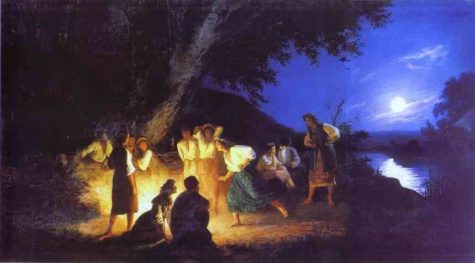
And Then It Was Banned
In the XVIII century, there were a number of documents testifying to the fierce struggle of the Church and secular authorities with the Kupala rite.
For example, in 1719 Hetman of Zaporizhzhia Army, Chairman of the Cossack state of the left bank of Ukraine, Ivan Skoropadskyi issued a decree “On parties, fisticuffs, gatherings on the holiday of Ivan Kupala etc.”, which granted the right to physically punish (tie up and beat with sticks) and excommunicate from the Church all participants of Kupala games.
In 1723, Przemysl Cathedral in Bereziv banned dancing and entertainment near the Kupala fire. In 1769, Catherine II issued a decree banning the holiday. And despite all the prohibitions, the pagan nature of folk rituals was strong. The church did not ban the holiday, but it did try to fill it with Christian content.
It is the pagan essence, mysticism, marriage-erotic motifs of Kupala rite that attracted the attention of many researchers and artists. Thanks to public ritual such art masterpieces as the Opera “Ivana Kupala” by S. Pysarevskyi; folklore work of L. Ukrainka “Kupala in Volyn”; the story of M. Gogol “Night of Ivan Kupala”; the film of Yurii Ilienko “Night on Ivan Kupala”; the Folk Opera of Y. Sankovych “When the fern blooms.” The latter during 40 years was banned and only in 2017 its world premiere took place on the stage of the Lviv Opera.
Kupala Today
At the beginning of the twentieth century Kupala rite gradually began to disappear. Today it exists in the “revived”, or rather “introduced” in Soviet times (during the anti-religious struggle) form of staged ceremony.
Although the magical meaning of rituals was leveled, and the celebration gained artistic value, the main pagan ritual actions have reached us – weaving of wreaths by girls and letting them into the water; honoring Kupala tree with dances; kindling the fire and jumping over the fire; ritual bathing; burning or sinking of trees; the burning of sacks of straw or stuffed dolls; the ceremonial dinner.
It is interesting that the name of the holiday, and the ritual fire, and decorated tree are called “Kupalo”, “Kupailo” or “Kupailytsia”. These are also the main elements of the rituals, which are based on the cult of fire, water and vegetation. Rituals symbolize the union of male (fire) and feminine (water) elements, were carried out with the aim of ensuring productivity, health, procreation.
On the territory of Ukraine for many centuries Kupala customs changed and they were not everywhere equally preserved. The majority were saved in Polissia as one of the more archaic zones of the Slavic world.
The holiday is still enthusiastically celebrated by the younger people of Eastern Europe. The night preceding the holiday (Tvorila night) is considered the night for “good humor” mischiefs (which sometimes would raise the concern of law enforcement agencies).
On Ivan Kupala day itself, children engage in water fights and perform pranks, mostly involving pouring water over people. Many of the rites related to this holiday are connected with the role of water in fertility and ritual purification.
According to ancient traditions, Ivan Kupala is the festival of the sun, and the most important role in mystical rites belongs to the power of fire. Our ancestors believed that the fire is the sun-embryo in the womb. Therefore, in the Kupala night taken to jump over the fire.
On Kupala day, young people jump over the flames of bonfires in a ritual test of bravery and faith. First, the oldest of the young men jumped over the fire.
For the highest jumpers it predicted a good harvest and prosperity for his family. Then pairs would jump, traditionally it would be a boy and a girl, but I assume that in some areas it’s permissible for pairs of any kind to take the jump together. If the couple is successful in their jump over the fire – they will certainly marry. The failure of a couple in love to complete the jump, while holding hands, is a sign of their destined separation. And anyone entering the flames during their jump can expect trouble
On the evening of July 6, unmarried girls take wreaths they have woven and throw them into the water. Unmarried men then try to grab the one belonging to the girl they are interested in. If you snag a wreath, the girl who made it will be expected to kiss you and the two of you will be paired up for the evening.
Girls may also float wreaths of flowers (often lit with candles) on rivers, in an attempt to gain foresight into their romantic relationships based from the flow patterns of the flowers on the river.
When the fun subsides, many people light candles from the hearth on pre-prepared wreath baskets and go to the river to put them on the water and thus honor their ancestors.
There is an ancient Kupala belief that the eve of Ivan Kupala is the only time of the year when ferns bloom. Prosperity, luck, discernment, and power befall whom ever finds a fern flower. Therefore, on that night, village folk roam through the forests in search of magical herbs, and especially, the elusive fern flower.
Traditionally, unmarried women, signified by the garlands in their hair, are the first to enter the forest. They are followed by young men. Therefore, the quest to find herbs and the fern flower may lead to the blooming of relationships between pairs within the forest.
It is to be noted, however, that ferns are not angiosperms (flowering plants), and instead reproduce by spores; they cannot flower.
In Gogol’s story The Eve of Ivan Kupala a young man finds the fantastical fern-flower, but is cursed by it. Gogol’s tale may have been the stimulus for Modest Mussorgsky to compose his tone poem Night on Bald Mountain, adapted by Yuri Ilyenko into a film of the same name.
Sources:
There is a lot to celebrate in July. This is a list of pretty much everything that goes on during the seventh month of the year. Many of these dates change from year to year. The days that change are marked with this » symbol.
July Lore and General Info

Astronomical Events
- July 3 thru August 11: Dog Days of Summer
- July 10 » New Moon
- July 12 thru August 23: Delta Aquarids Meteor Shower
- July 17 thru August 24: Perseids Meteor Shower
- July 24 » Full Moon – Buck Moon
Astrological Events
Depending on which astrological system you adhere to, these are the signs that show up in July of 2021. Be aware that some of these dates will vary from year to year. Unlike the Sun signs which might just shift by 1 or 2 days, the dates of the various Moon signs will vary widely from year to year. The same holds true for the Chinese Zodiac. The Celtic Tree Signs are based on an arbitrary system and stay the same from year to year.
Western Astrology
The July Sun begins in Cancer and finishes up in Leo:
- Jun 21 thru Jul 22 » Sun in Cancer
- Jul 22 thru Aug 22 » Sun in Leo
The moon cycles through the signs as follows:
- Jun 1 – Jul 3 » Moon in Aries
- Jul 3 – Jul 6 » Moon in Taurus
- Jul 6 – Jul 8 » Moon in Gemini
- Jul 8 – Jul 11 » Moon in Cancer
- Jul 11 – Jul 13 » Moon in Leo
- Jul 13 – Jul 15 » Moon in Virgo
- Jul 15 – Jul 17 » Moon in Libra
- Jul 17 – Jul 19 » Moon in Scorpio
- Jul 19 – Jul 21 » Moon in Sagittarius
- Jul 21 – Jul 24 » Moon in Capricorn
- Jul 24 – Jul 26 » Moon in Aquarius
- Jul 26 – Jul 28 » Moon in Pisces
- Jul 28 – Jul 30 » Moon in Aries
- Jul 30 – Aug 2 » Moon in Taurus
You will notice that the Moon might begin the day in one sign and by the end of the day may have moved into another sign, so timing matters if you are wanting to be precise.
The Celtic Tree Signs in July:
- Oak: Jun 10 – Jul 7
- Holly: Jul 8 – Aug 4
The Alternative Celtic Zodiac is as follows:
- Apple: Jun 22 – Jul 2
- Fir: Jul 3 – Jul 13
- Elm: Jul 14 – Jul 24
- Cypress: Jul 25 – Aug 4
The Chinese Calendar and Zodiac
We are currently in the year of the Ox (sometimes referred to as the Cow). Each Month is also assigned a specific animal. Here’s what shows up in July 2021.
- Horse: Jun 5 – Jul 6 (Chinese Zodiac – Stem Branch Calendar)
- Horse: Jun 10 – Jul 9 (Lunar Calendar – 5th Lunar Month)
- Sheep: Jul 7 – Aug 6 (Chinese Zodiac – Stem Branch Calendar)
- Sheep: Jul 10 – Aug 7 (Lunar Calendar – 6th Month)
Note: The traditional Chinese Astrology birth chart is built by the Chinese Stem Branch Calendar, not the Chinese Lunar Calendar, which I think is really confusing. Because of a difference in time zones, the lunar months will have different pattern between China and the USA.
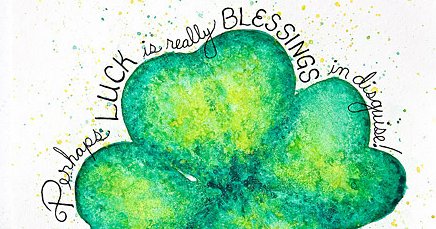
Lucky and Unlucky Days
You might want to plan moving, traveling, major purchases, court dates, and weddings around these dates, avoiding the unlucky days and utilizing the lucky ones.
- These are the lucky days in July:
9, 15 and 28. - These are the unlucky days in July:
3, 10, 17, 18 and 21.
Fatal Days
The thirteenth is a fatal day,
The tenth alike will mortals slay.
Holidays and Holy Days
Many of the holidays begin on the eve of the night before and end on the eve of the day of. It’s also important to remember that the dates of archaic festivals and feast days may vary widely depending on the source.
July 1
- 1: Canada Day
July 2
- 2: Feast of Expectant Mothers
- 2: World UFO Day (sometimes celebrated on June 24)
July 3
July 4
- 4: Independence Day
- 4 » Dakini Day (Tibetan)
July 5
- 5: Poplifugia
- 5 » Day of Ekadashi (Hindu)
- 5 thru 21: Naadam Festival
July 7
- 7: Festival of the Handmaidens – Nonae Caprotinae (“the nones of the wild fig”)
- 7: Festival for the Pales (also on Apr 21)
- 7: Tanabata – The Star Festival (Japan)
- 7: Rumilia Festival – see also Poplifugia
July 9
July 10
- 10: Day of Hel
- 10: Festival of Knut the Reaper
- 10: Lady Godiva Day
July 11
- 11 » The Noumenia
July 12
July 13
- 13 thru 15: OBon Festival – see also Aug 13 – 15
July 14
- 14: Bastille Day
July 15
- 15: Day of Rauni
July 16
- 16: World Snake Day
July 18
- 18: Day of Bad Omens – Black Day (Also Oct 6)
July 19
- 19 » Umi no Hi – Marine Day
- 19: Lucaria
- 19 and 20 » Eid al-Adha
July 20
- 20 » Day of Ekadashi (Hindu)
July 23
- 23: Neptunalia – the festival of Neptune, the Roman god of the sea.
- 23 thru Aug 1 » Boryeong Mud Festival
July 24
- 24 » Asalha Puja Day
- 24: Pioneer Day
July 25
- 25: Plant A Turnip Seed Today
- 25: A Day Out of Time
- 25: Furinalia
- 25: Day of Aegir and Ran
July 27
- 27 thru 31: The Five Epagomenal Days
- 27: Birthday of Osiris
July 28
- 28: Birthday of Horus
July 29
- 29: Birthday of Set
- 29: Honoring The Thunder God
- 29: Stikklestad Day – Honors the Asatru martyrs who died rather then submit to gray slavery.
July 30
- 30: Birthday of Isis
July 31
- 31: Birthday of Nephthys

Saint Days
There is a surprising amount of magick associated with Saint days. This is a very short list of the Saint days in July, there are many many more. As time goes by I may end up listing them all, but for now, this is what I have.
- 11: St Benedict Day
- 15: St. Swithin’s Day
- 15: St. Vladimir the Great Day
- 16: Feast of Our Lady of Carmel
- 22: Feast of Mary Magdalene
- 23: Saint Anne’s Eve
- 25: St. James the Great Day
- 26: Feast of St Anne

Recipes For July
Many more seasonal recipes, including recipes for new and full moon ceremonies, ancient Greek and Roman holy days, Asian festivals and etc can be found here: Seasonal Recipes.
![]()
Notes:
Any July lore, almanac, astrological, and celebration dates that have been shared after this post was published can be found by searching the July posts to see what’s new.
A lot of work went into this post which was compiled from various sources by Shirley Twofeathers for The Pagan Calendar. You may repost and share without karmic repercussions, but only if you give me credit and a link back to this website. Blessed be.
Oak month falls during a time when the trees are beginning to reach their full blooming stages. The mighty Oak is strong, powerful, and typically towering over all of its neighbors. The Oak King rules over the summer months, and this tree was sacred to the Druids.
The longest day of the year and the shortest night fall during the Oak Month. Known as the Summer Solstice, celebrations revolve around the power of the Sun at its zenith. Folklore decrees that “He who sleeps on the shortest night shall sleep all year”, meaning that this is a time for action not rest.
- Dates: June 10 – July 7
- Celtic Name: Duir
- Language of Flowers: Bravery, Hospitality
- Qualities: Tree of the Gods, Strength, Power, Longevity, Endurance, Sacred, Fire, Lightning, Protection, Love, healing,
- Themes: Strength, Power, Fertility, Luck, Success.
The Oak tree has long been venerated by people of many cultures as a symbol of strength and power. The Celts called this month Duir, which some scholars believe to mean “door”, the root word of “Druid.”
The Oak is connected with spells for protection and strength, fertility, money and success, and good fortune. Carry an acorn in your pocket when you go to an interview or business meeting; it will be bring you good luck. If you catch a falling Oak leaf before it hits the ground, you’ll stay healthy the following year.
Feel energized by the power of the Sun and Oak during this energetic time of year. Harness powerful solar energies for Oak Moon work to bring cheer and success to your life. Energy at this time should concentrate on areas of life that fall under sunny auspices such as health, success, prosperity, and blessings. Cast energy that injects solar flare into your projects by decorating you home with gold and yellow. Wear orange to boost your vitality and stamina.
Often linked with the fairies and ghosts, Midsummer brings the perfect opportunity to summon assistance from the spirits. Ask for help to being beneficial results from creative plans.
Oak the Stabilizer
The Celtic druids knew that, when a child was born under the Oak sign, it’d possess a special gift of strength. People from this Celtic tree astrology sign become protectors of the weak and speak for those who don’t have a voice. They are generous, helpful, and gentle. The Oaks have a deep understanding of history and ancestry and maybe that’s the reason why many of them become teachers.
Oak is a manly tree, and the people born under its rule are “people of action”. These people were given the ability to be the protectors of the weak and oppressed. They are literally the embodiment of spiritual power, great courage and determination.
Oak people are usually well-built and physically strong. They are straightforward and honest. They always try to find the easiest way to achieve their goal; they never shy away from dealing with problems and never use intrigues or do something that is not right.
Suitable partners for this crusader of the Celtic tree zodiac are Ash and Reed, but can reach harmony with Ivy signs too.
Oak Magick and Lore
The Oak is a sign of strength, both the strength of its branches and wood, and its strengthening qualities as a medicine and magical tree. All cultures have revered the Oak and sought such strengthening qualities, and that strength can be seen throughout the lore.
Tied to the ancient term for “druid” as “Oak knowledge” Oak has long been associated with knowledge and wisdom. We can see this also in the Native American lore, where Oak “makes space for councils”.
The Oak can be used as a haven for restoration. When your spirit needs rest and comfort it can be soothed beneath the tree’s vast branches and many sacred rituals were conducted in the shadow of an Oak tree in Ancient Britain. Meditating with your spine resting on the trunk of an Oak tree soothes the nervous system and induces feelings of inner peace.
Oak trees conduct the energy of endurance and strength, offering a magical remedy for fear and despair. They bring courage and protection from adversity.
The great size and age of the Oak made it a symbol of the continuity of the community. The water that collects in the dips in its branches was though to be sacred and used to cleanse and heal the body of negative energy.
Each Oak tree was believed to be the home to a multitude of faeries and each acorn was thought to be the home to a sprite. Bringing an acorn into the house was one way to develop a stronger relationship to the faerie world.
Oak has low electrical resistance and is often struck by lightning. So forests of Oak attracted violent electrical storms – and as lightning was seen as a message from the gods, so Oak came to be associated with the gods of storm, thunder, and lightning.
Thunder was said to be the voice of Zeus – and an Oak tree that had been struck by lightning was believed to be particularly sacred.
A purification ritual for the Oak Moon
You can burn Oak leaves to purify the atmosphere and banish fear and doubt. You will need:
- Small bottle of wine
- Basket
- Pestle and mortar
- Needle and thread
- Fireproof bowl
- Charcoal disc and matches
On the night after the full moon go to an Oak tree and pour a libation of wine onto the roots, asking the tree for its help. Gather a basket of leaves and sew them together, then hang up the leaves to dry out for three days.
When the leaves have dried, carefully remove the thread and pound the leaves with a pestle and mortar into incense. Light the charcoal in the fireproof dish. When it glows red add the dried leaves to create an energetic purification smoke.
Sources:
The Birthday of Zarathushtra, one of the most important Zoroastrian festivals. Regarded as one of the most significant festivals of the Parsis, it is also referred to as Navroz-I-Khas. Although the actual date of his birth cannot be accurately identified, the festival of Khordad Sal symbolically celebrates the birthday of Prophet Zarathushtraz on the 6th day of the first Parsi month, Farvardin.
This date, however, falls on different days depending upon which of the three religious calendars are followed, and on those dates will vary from year to year, here are the dates for 2021:
- Fasli (Iranian): March 26
- Qadimi (Kadmi): July 22
- Shenshai: August 21
Who is Zoroaster?
Zoroaster, also known as Zarathustra, was the founder of Zoroastrianism. Some accounts place his birth in western Iran, perhaps near Tehran, however based on the dialect of his poetry, it seems likely that he was born in the east. He is credited with the authorship of the Yasna Haptanghaiti as well as the Gathas, hymns which are at the liturgical core of Zoroastrianism.
There is no consensus among scholars about when he was born. The estimated dates of his birth range from 6000 BC to 100 BC. The majority of his life is known only through the Avestan texts. It is possible that Zoroaster was a purely mythological person or that the writings attributed to him are actually the work of multiple authors who wrote under the same name. All of the details have been lost in antiquity.
Legend says that when his mother was five months pregnant, she had a nightmare about the ending of the world. But then an angel appeared to her, and told her that her unborn child would become a great prophet who would be able to reverse the impending destruction.
It is said that his face was shining at the moment of his birth, and that it is on account of this that he was named Zarathustra, which according to one translation means ‘golden (zara) light (ushas)’; according to another it means ‘yellow (zara) camel (ushtra)’, a translation perhaps more in keeping with the pastoral society into which he was born.
Celebrating The Day
Khordad Sal is the equivalent of Christmas for Christians, and it is a day of great festivities and celebrations.
Khordad means perfection, and it is customary on this day to visit the Fire Temple to give thanks to Ahura Mazda, the Persian name for the one God, for giving humanity the ideal gift of the Prophet Zarathushtra. His followers participate in a jashan or thanksgiving ceremony; listen to stories of his miraculous birth and life; and then celebrate with a lavish community meal, a drink and a dance.
On this day people get busy with cleaning their homes and decorating them with rangoli, colored sand spread on the floor in different patterns. Fragrant flowers are used for further beautifying the homes. People get up early on the day of the festival and don their newest and finest clothes. They prepare traditional foods as part of the luxurious dinner that forms a major part of the celebrations.
The tables are decorated in a special fashion as part of the festivities. Foods and flowers are the main highlights at the table. They are accompanied by dishes of nuts and candies. The different delicacies prepared include kebab, chelo, fish and seasonal fruits, such as melons, nectarines and apples.
The Parsis also visit fire temples or places of worship to offer thanks to Ahura Mazda and remember the birth of their prophet. A special ritual followed is Jashan, or thanksgiving prayers to give thanks for and celebrate the soul that evinced a philosophy of life that is both giving and fulfilling, which is performed in the agiaries. A grand feast follows this ritual in the temples.
Because this is a time to unite and mingle with near and dear ones, Khordad Sal gives the Parsis an opportunity for togetherness and to make resolutions for the upcoming year ahead. People exchange gifts and salute each other with the greeting: Khordad Sal Mubarak!. Prayers are offered and are followed by festive parties
Typically a day for family gatherings, however, if families are unable to be together then prayers are offered for those who are not in attendance. It is an important celebration for the Parsi community, and because family (and community) is central to the themes of Zoroastrianism, guests are invited to participate in the festivities.
Parsis also take the time during Khordad Sal to be introspective. They look at ways in which they can improve the lives of others and themselves.
About The Zoroastrian Faith
Zoroastrianism, also commonly known as Mazdaism is one of the oldest monotheistic religions in the history of humanity. Very little is known about it. The religion is pillared on the belief in the existence of heaven and hell, the Golden Rule (do unto others what you want to be done unto you), messianism and free will.
Zoroastrianism was for ages the world’s most powerful religion, termed by some as ‘The Supreme Religion.’ The 7th century saw a rise in the suppression of the religion. The suppression was a result of the victory by the Muslims in conquering the state of Persia. The Zoroastrian faith has endured many hardships, the most significant being the invasion into Iran by Alexander and later, the Arab conquest of Iran.
The three tenets of the religion include good thoughts, good deeds, and good words. Zoroastrianism believes there is only one supreme, universal and transcendent God, the Ahura Mazda, “Wise Lord.” They believe that Ahura Mazda discovered the world and then passed on all the teachings through the Prophet Zoroaster.
Though greatly diminished in numbers, Zarathustra’s followers have continued to honor his revolutionary teachings for over 3000 years. Most modern Zoroastrians live in India, although smaller communities exist around the world.
As Zoroastrian numbers continue to dwindle, courts battle ancient rules in the 21st century. Tradition forbids women who marry non-Parsi Zoroastrians from ever again entering fire temples, and as more and more followers enter interfaith marriages, leaders question the religion’s ability to continue in the world.
Sources:
According to some calendars, March 3rd is Aegir’s Day, this has also been referred to as the Celtic Sea Festival. The Pagan Book of Hours has a day for Aegir and Ran listed as July 25.
Ægir or Aegir is a Norse sea jötunn, a mythological giant (sometimes called a Frost Giant) and God of the sea. He’s also the brewer to the gods of Asgard. Aegir is also a God of brewing known for the beer he brewed in an enormous cauldron stolen from the giants by Thor and Loki. (Read that story here: Aegir’s Feast.)
He hosted elaborate parties, providing home-brewed ale in enormous pots. His mugs would magically refill themselves with more ale.
Married to the goddess Ran, they have nine daughters who each personify different kinds of waves.
Party and Celebration Ideas
To celebrate, have a party with a local microbrew and smørrebrød.
Roast Beef & Pickle Smørrebrød
- 1 slice rye bread, crust trimmed off
- 1/2 teaspoon unsalted butter, slightly softened
- 1/8 lb. sliced roast beef, cut into squares
- 2 to 4 cornichons (gherkins), thinly sliced lengthwise
- fried onions, (recipe below)
- 1 teaspoon prepared horseradish
Spread bread evenly with butter. Arrange roast beef on butter. Arrange cornichons and onion on top. Top with a dollop of horseradish.
Fried Onions
- Thinly slice a white onion.
- Soak in cold water for 10 minutes.
- Drain, then dredge onion in flour.
- Fry in hot oil until golden brown.
Ceremony for the Day of Aegir and Ran
- Date: July 25 – also known as 25 Haymonath
- Colors: Sea-blue, sea-green.
- Element: Water
- Offerings: Singing. Blood given to the ocean. Aid those who clean the seas.
- Song: Harp Song of the Dane Women, along with any other sea songs, sung as offerings.
- Daily Meal: Seafood.
Altar:
Upon cloth colored like the sea place shells, nets, figures of fish, sea floats, and anything that comes from the sea. Place there also a cup of wine with flecks of gold in it.
Invocation to Aegir, Ran, and the Nine Sisters
Lord and Lady of the Depths,
Keepers of the great flocks and herds
That float by the millions
Through glass-green waves,
Lady Ran of the ten-times-fingering weed,
Your hair spread throughout the worlds,
Lord Aegir of the great currents
And the waves that keep the ship afloat,
Generous in your bounty,
Capricious in your favor,
Brewer of ale for gods and lost souls,
Keep us safe as we pass over your realm
In life, in dreams, and in mystery.
Nine Sisters of the Waves, Sacred Undines,
Daughters of Aegir and Ran, fish-tailed,
Blood on your hands and beauty in your song,
We hail you from the shores, the depths, the heights of sea-cliffs.
Kolga the Cold One, Ice-Maiden of the floes and castles.
Duva the Hidden One, Keeper of island treasures.
Blodughadda, Blood-Haired One, shark’s delight.
Hronn, Sucking Whirlpool, Eel-daughter and Mistress of Fear.
Hevring, Heaving Storm, Mourning’s Mistress.
Bara, Great Wave of the Whale, battering the land’s stalwart stand.
Bylgja, Breaker’s Dancer, Rider of the Wave-Horse.
Unn, Billowing Tides, Maiden of the Counting Moon’s Rhythm.
Himinglava, Fair-Weather Mermaid, Sun Shining Through.
Teach us by the Powers of Water
How to find the way to our own souls.
Petitioning Aegir
Aegir is the presiding spirit of the ocean. He may also be understood as actually being the ocean. This ancient deity is beloved but feared. Petition him for safety on the seas and to reveal the secrets of the deep. Aegir knows everything. He is a well of knowledge and can theoretically fill any request or recruit another deity who can.
Petitions should always be accompanied with offerings. An altar may be built for him, or offerings may be brought to the sea. Be generous. He’s a king.
Give him objects reminiscent of the sea. Give him fine old coins – sailors once carried them so that in case they drowned, they wouldn’t arrive at Aegir’s hall empty handed. Serve him mead and ale, acknowledging that you know it’s nowhere near as good as what he serves at home.
Aegir – The Moon
Aegir, originally called S/2004 S10, is a natural satellite of Saturn. Its discovery was announced on May 4, 2005, from observations taken between December 12, 2004, and March 11, 2005.
Aegir is a member of the Norse group of moons. These “irregular” moons have retrograde orbits around Saturn—traveling around in the opposite direction from the planet’s rotation. Aegir and the other Norse moons also have eccentric orbits, meaning they are more elongated than circular.
Like Saturn’s other irregular moons, Aegir is thought to be an object that was captured by Saturn’s gravity, rather than having accreted from the dusty disk that surrounded the newly formed planet as the regular moons are thought to have done.
Aegir is about 6 kilometres in diameter, and orbits Saturn at an average distance of 19,618 Mm in 1025.908 days, at an inclination of 167° to the ecliptic (140° to Saturn’s equator), in a retrograde direction and with an eccentricity of 0.237.
The moon was named in April 2007 after Ægir, a giant from Norse mythology, the personification of tranquil seas, the one who soothes storms away. He is a son of Fornjót, and brother of Logi (fire, flame) and Kári (wind).
The name may be pronounced various ways. /ˈaɪjɪər/ (with the ‘g’ pronounced as a y-sound) approximates modern Norwegian and Icelandic. /ˈæɡɪər/ (with a hard ‘g’) approximates what the Old Norse may have sounded like, while the Latinized/spelling pronunciations /ˈiːdʒɪər/, /ˈɛdʒɪər/ and /ˈeɪdʒɪər/ are also found.
Aegir – the Tidal Bore
Aegir also gives his name to the tidal bore on the river Trent (in England) which is particularly powerful around the equinoxes. At certain times of the year, it is possible to see a bore of up to five feet high.
Aegir is said to rush up the river to try and reclaim the surrounding land and expand his watery kingdom.
The Trent Aegir is also known as the Eagre. The Aegir occurs when a high spring tide meets the downstream flow of the river forcing it back and causing a wave to flow upstream. Typically it is possible to see the bore from Derrythorpe to as far up the river as Gainsborough. Beyond Gainsborough the bore is reduced to a ripple.
The best places to see the Aegir are at Gainsborough, Morton, East Stockwith, West Stockwith and Owston Ferry.
The tidal bore is notoriously difficult to predict as there are several factors involved in its appearance but the Crowle Community Forum at Crowle.org does have an Aegir timetable which you can check out. (2021 predictions)
Sources:
“I want to believe.” These are the words of notorious X-Files hero Fox Mulder, who convinced an entire generation that the truth is out there – we just have to find it. But on July 2, it won’t only be sci-fi enthusiasts trying out their ET sleuthing skills, as everyone on planet earth will have to opportunity to celebrate World UFO Day.
World UFO Day is an awareness day for people to gather together and watch the skies for unidentified flying objects. The day is celebrated by some on June 24, and others on July 2.
The stated goal of the July 2 celebration is to raise awareness of “the undoubted existence of UFOs” and to encourage governments to declassify their files on UFO sightings. So why July 2? For many, this date represents the anniversary of the famed and all-but-confirmed 1947 incident in Roswell, New Mexico. Believers claim a UFO crash landed here, deep in the American southwest, but that the government has been covering it up ever since.
June 24 is the date that aviator Kenneth Arnold reported what is generally considered to be the first widely reported unidentified flying object sighting in the United States.
UFOs have been the stuff of legend for centuries, but it wasn’t until the 1950s that freaky flying saucers grabbed national and international mainstream attention. Since then, UFOs have captured the minds of old and young alike, and witness’ stories have proliferated around the world. World UFO Day serves as a way for everyone to come together and watch the skies on the same night in search of UFOs, but that’s not its only purpose.
Many see the holiday as a way to spread knowledge and awareness of UFOs, making a case for their existence, and hoping to make disciples out of the dubious. What do you believe?
And no matter what you believe, World UFO Day is an opportunity to think laterally, creatively, and perhaps even a bit unconventionally. We are encouraged o challenge accepted knowledge, and for once, maybe it’s okay for our minds to be off in space. 🙂
What is a UFO?
The letters UFO stand for Unidentified Flying Objects. Most of the flying objects that occur on earth are generally from our earth and heavily monitored with technology. UFOs are generally classified as anomalies that are completely unidentified and in identifiable. The most general definition of the UFO is something that’s apparent in the sky that is not identifiable as any known object or natural phenomena.
Identification of a UFO
Normally what happens with UFOs is that they are identified later or explained as a natural phenomenon but until a flying object is identified as being man-made or natural phenomena it keeps its title as a UFO.
The title of UFO was originally created in 1953 by the United States Air Force so that they could record and review any instances where a flying object was logged in official reporting.
Throughout the 1940’s and the early 1950’s UFOs were more commonly called flying saucers are flying discs. This image of a UFO seemed to persist through early sci-fi folklore and only really became UFOs during the Cold War with an interest in national security.
Everyone involved in the Cold War conflict was testing new types of aircraft, missiles and more throughout this time. As a result any unidentified flying object needed to be logged and heavily reviewed. This really became one of the first large-scale reporting efforts for UFOs in the world and since UFOs became a natural security concern there have been reports almost worldwide that are consistently reviewed almost every day.
Although most people are quick to associate UFOs with conspiracy theories or a cultural phenomenon it possible that one day one of these unidentified flying objects could prove an association with extraterrestrial life.
Some of the top 20th-century UFO accounts include:
- Foo Fighters: during the 1940’s over the world war theaters small metallic spears and colorful balls of light were seen and even photographed by bomber crews throughout World War II.
- Roswell: one of the most talked about cases in New Mexico as onlookers described the crash of an unidentified flying object.
- The Phoenix lights: in 1997 thousands of people saw V-shaped patterns in the sky for space of around 300 miles from the Nevada line.
There are new reports coming in nearly every year including mass UFO sightings in Houston Texas and Colorado sightings as early as October of 2014.
With so many instances occurring around the world user phenomena that we need to understand. Until more spending and research goes into the identification of these cases we may simply be left with more questions as to what the nature of a UFO is.
How to celebrate World UFO Day
Celebrating UFO Day happens in a lot of different ways, and the number of ways is as varied as the potential number of intelligent species in the known universe. UFO Enthusiasts gather around the world in known UFO hotspots like Roswell New Mexico to share stories, provide support for other believers, and watch for the return of visitors in the night sky.
But this is hardly the only way to celebrate it, if you live in a small community of supporters or are merely quite far from the nearest large one, you can organize it yourself. Getting together with friends and family to watch UFO movies and share the gospel of the little green man is a great way to support awareness of UFO’s and the copious evidence out there supporting their existence.
- Have a “Welcome to Earth” party
In case you needed a reason to throw a party, there’s plenty of opportunity here. Alien and UFO costumes are simple and funny, while the food ideas are endless. Alien cupcakes with green icing, red jello with rocket ships suspended in the middle or even prepackaged moonpies are all great ideas. For an older-earthlings party, try mixing vodka, blue curacao, grenadine, cranberry juice and sours for a Purple People Eater cocktail.
- Do some investigative research.
There are more than enough stories, legends and actual scientific findings on UFOs and space exploration to keep you busy for a day. Use the power of the internet to separate fact from fiction, and try coming up with your own theories on whether the truth really is out there. Here’s a link to some of the Top UFO Documentaries. Finish the evening by gazing up at the stars before going to bed. You never know what you might see.
- Have a UFO movie marathon
Depending how far you want to go back, try watching a few UFO films from different eras. Here’s a link to a list of Top Rated UFO and Alien Movies. The Flash Gordon-types of the 30’s were genre-defining. The Martian marauders story typical of the 50’s and 60’s may be a bit campy for you, but you could have some friends over to watch them a la Mystery Science Theater 3000, and let the heckling begin. Or settle in for the visually stunning films of the last few decades – take your pick, sit back, and blast off.
Whatever you do, keep your eyes to the sky for World UFO Day.
Sources:
- World UFO Day
- Wikipedia
- National Today
- Days Of The Year
